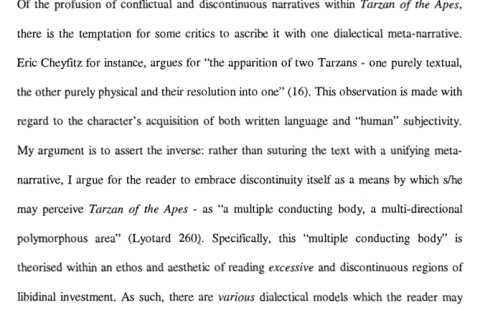
Edgar Rice Burroughs and “The Damphool Species of Narrative”
Elsewhere on this site there is a raging argument going on between two otherwise sane and reasonable guys over whether a) Andrew Stanton has silly ideas, b) Edgar Rice Burroughs has silly ideas, c) both have silly ideas, or d) neither have silly ideas. In reading the comments I couldn’t help but think of ERB’s famous letter proposing Tarzan of the Apes in which he says: “I am especially adapted to the building of the damphool species of narrative.” After reading that — I don’t think anyone can say Burroughs would object too strenuously to the notion that some of his ideas are a bit silly. But ah….could he sell them? Oh yeah….
Meanwhile, that one glorious statement of his “damphool”ishness is enough to make me love good old ERB not only for his writing, but for his sense of humor–it makes me certain that aside from reading his books, I’d like to spend a long evening over a bloody steak and a bottle of scotch with him. What fun that would have been.
Anyway, as I was searching for the “damphool” quote I googled “Burroughs damphool” and up popped this very interesting scholarly piece entitled: “”A damphool species of narrative”: towards a reading of “excess” in Edgar Rice Burroughs’ Tarzan of the Apes”.
I was excited — there’s a wannabe English professor buried away somewhere in my consciousness, and I’ve sat through my fair share of graduate seminars on the modern American novel, structuralism, and you name it … so I figured that a scholarly piece quoting Burroughs “damphool” comment would make great after dinner reading for me.
Um … well — I give you one of the early paragraphs– in fact, since it would cause amy finger to contort to type this (it exists in a screen capture PDF only so I can’t copy paste the words), I will put in here as a graphic.

Can anyone out there decipher that?
I’m offering a bounty — heavy dose of recognition on the John Carter Files (well a minor bounty, that) — for anyone who can read this entire article, decode it, and offer a coherent explanation of what it’s about.
Baeder Garland, are you listening? This could be one for you!
[[UPDATE–BAEDER HAS SPOKEN — SEE HER COMMENT.]]
http://digital.library.adelaide.edu.au/theses/09AR/09arv882.pdf
Meanwhile, Michael Uebel writes in “Race and the Subject of Masculinities” something that I find a tad more coherent and compelling:


8 comments
Exactly. ERB would never have allowed himself to be “precious” …. he would have fought any such impulse as evidence that he was suddenly taking himself seriously, which he resolutely sought to show that he was not. (How’s that for tangled syntax?)
A “damphool” species of literary criticism?
Seriously, any time a writer insists on using obfuscating jargon he shouldn’t expect to be taken seriously, and the clarity of his though processes is thrown into question.
Thanks for the post, Michael. It’s a good reminder that ERB was always humorously self-effacing about his writing and never took himself too seriously . . . which makes me wonder if we shouldn’t take a cue from the master. Maybe I and others ought to lighten up a bit about Stanton’s changes and just enjoy the ride for what it is?
Why do you think I tossed it out there and asked for help? 😉
I just put another quote on the end of the article that makes more sense to me. Check it out. From another book.
If you can wade through all 56 pages …. you deserve special recognition indeed!
Do you know that thing is 56 pages long? Sorry, no-can-do at this time of night. My brain works best from 9:00 am – noon.
Bravo!
Baeder G and Good ol’ Lyotard to the rescue again!
Thank you!
Oh, wait, you said read the WHOLE article? I just read that little blurb. I have to try again.
Challenge accepted! (However I had to use google for help)
A metanarrative is a story about a story, encompassing and explaining other “little stories” within conceptual models that make the stories into a whole.
Modernists and philosophers address the problem by telling a story—the story of progress through universal human reason, as Logos triumphs over Mythos. The problem is that once a proof is accepted as the standard of believability not only must we prove our claims, we must also prove our proofs, and so on, ad infinitum. (as defined by Lyotard… does anyone else find his name funny?)
Some argue that the reader can accept the “conflictual and discontinuous” narratives in TARZAN by stating that it is a meta-narrative.
This author says that you don’t have to give a reason why it makes sense (calling it a meta-narrative), just embrace the discontinuous nature of the text, and the more you read it, the more you mind accepts its plausibility…i think.
Then again, I still haven’t read Tarzan. We have it at the house, I just haven’t got to it yet:)